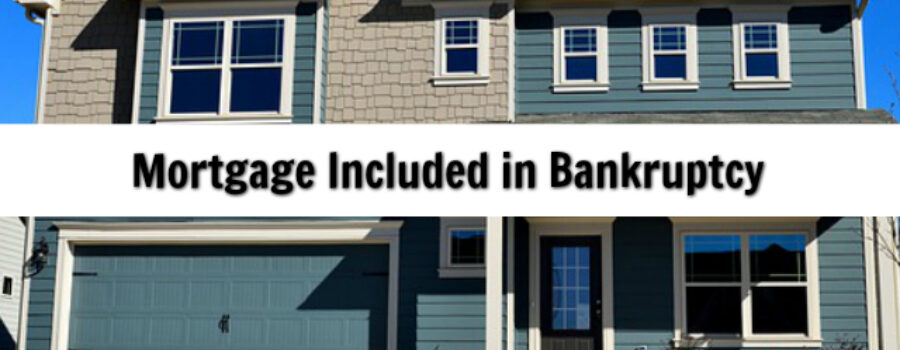There is an interesting guideline with a conventional Fannie Mae mortgage, where the waiting period to obtain new home financing is based on the bankruptcy discharge date, NOT the foreclosure date when mortgage is included in bankruptcy.
This post is for anyone who has ever had a home included in their bankruptcy, and are looking for answers on when they can buy a new home.
Waiting Period – Mortgage Included in Bankruptcy
Let me paint a picture for you to make sure we are on the same page on when this guideline is used.
You filed bankruptcy and listed your home and mortgage(s) tied to the home as included in the bankruptcy.
The bankruptcy was discharged in 2014, but the home that was included in the bankruptcy was not foreclosed until 2017.
Most lenders will tell you that you have to wait 7 years from the foreclosure date before you will be eligible for conventional financing. This is either because the loan officer is unaware or because their company has an overlay that doesn’t allow this guideline.
But wait a minute, you surrendered that property in the bankruptcy 4 years ago. The guideline states that when including a mortgage/home in a bankruptcy, the waiting period is based on bankruptcy discharge date, NOT the foreclosure date.
This is ONLY on conventional Fannie Mae loan. This guideline does NOT apply on FHA loans.
Who should pay attention
This guideline is for borrowers who vacated the property at the time the bankruptcy was discharged, or around that time. Remember, your intent was to surrender the home as part of the bankruptcy. If you stayed in the home, and were mortgage/rent free for several years, and then expect to buy a house buy using this guideline, there is a good chance the loan will be declined.
The guideline is not designed to help if you did not truly surrender the home when the bankruptcy was discharged.
If you did vacate the property, and got into a rental, paid your rent on time as promised – this guideline is perfect for you.
It is extremely common for lenders to not complete foreclosure proceedings for several years after the home was surrendered in bankruptcy. But this guideline is what saves the day.
Here is the guideline straight from Fannie Mae:
If a mortgage debt was discharged through a bankruptcy, the bankruptcy waiting periods may be applied if the lender obtains the appropriate documentation to verify that the mortgage obligation was discharged in the bankruptcy. Otherwise, the greater of the applicable bankruptcy or foreclosure waiting periods must be applied.
On conventional mortgage loans the waiting period is 4 years from chapter 7 bankruptcy discharge date. Chapter 13 bankruptcy requires 2 years from discharge date or 4 years from the dismissal date.
But if chapter 13 was dismissed, that means the bankruptcy wasn’t completed. This means the debt wasn’t settled per the agreement. So if you foreclose in that scenario, the waiting period will be 7 years.
Where to Look
The guideline above states that the lender must obtain appropriate docs to prove that the mortgage was included in the bankruptcy. What does that mean?
It’s pretty simple actually (if you retained copies of all your bankruptcy docs, not just the discharge).
When filing bankruptcy, there are many schedules (different sections) that are drawn up that identify assets and liabilities that are included and excluded in/from the bankruptcy.
What you are looking for:
- Schedule A (Real Property – Real estate that is owned by the person filing bankruptcy)
- Schedule C (Property claimed as exempt from the bankruptcy) – If your property is listed on the schedule C that means you do NOT intend to surrender the home in the bankruptcy
- Schedule D (Creditors Holding Secured Claims) – This is where you will find the mortgages or other debts that are included in the bankruptcy
Chapter 7 Bankruptcy
With chapter 7 bankruptcy, it is pretty straight forward. If you mortgage was not reaffirmed, your mortgage was surrendered in the bankruptcy along with all of the other debt you listed.
Once the bankruptcy is discharged, your obligations are gone essentially.
Chapter 13 Bankruptcy
With chapter 13 bankruptcy it gets a little tricky. Traditionally, chapter 13 bankruptcy is considered to be a “reorganization of debt”, enabling individuals with regular income to develop a plan to repay all or part of their debts. You and your creditors agree to new terms on your debt per the bankruptcy terms, and you retain the assets associated with that debt. You make your payments per the bankruptcy and once all of your payments have been made, the debt or delinquency is settled.
Some people use chapter 13 bankruptcy as an instrument to actually save their homes from foreclosure. In those cases, typically the mortgage debt that is included in the bankruptcy is any arrearage (past due payments). So the bankruptcy in this case, would act as a tool to help you keep the house while getting caught up on what you owe. In this case, the home would be listed on the Schedule C in the bankruptcy (property claimed as exempt from the bankruptcy).
However, there are many cases where the home and entire mortgage is included in the chapter 13 bankruptcy. If that is the case, the home will NOT be listed on the Schedule C (property claimed as exempt from the bankruptcy), and the home is considered to be surrendered.
Special Note for Chapter 13
When the home is surrendered in chapter 13 bankruptcy, you may need more than the schedule C to convince the underwriter that the home was in fact surrendered in the BK. This (again) is because traditionally chapter 13 is considered reorganization of debt.
Showing additional proof – Each state is different, but if you’re looking to show further evidence of home being surrendered in the bankruptcy, look for a form stating: Chapter 13 Plan and Motions. This will once again declare what is to happen with the real estate, and the debt tied to that real estate upon successful completion of the chapter 13 bankruptcy.
If the home was surrendered, the chapter 13 plan and motions will state it accordingly.
Alternative
If it turns out you do not meet traditional lending standards and guidelines, a portfolio loan may be the alternative solution for you.
A portfolio loan is a mortgage designed for borrowers who don’t qualify for traditional home financing.
Whether the issue is credit related or otherwise, a portfolio loan may be the solution to get you into the home you’re looking to buy while you wait on appropriate time to pass before being eligible for traditional financing.
More on portfolio loans here.
The Most Important Thing
Keep records of all bankruptcy documents.
I cannot tell you how many times I request bankruptcy documents, and all that is provided is proof of discharge.
In order to document everything properly (and make an appropriate lending decision), lenders need all documents associated with the filing. This also includes any schedules, amendments, and discharge of the bankruptcy in question.
If you have had a mortgage included in bankruptcy, and have been told you need to wait to buy a new home based on foreclosure waiting period:
I invite you to reach out.
Get your questions answered.
If I cannot help, I should be able to point you in the right direction at the very least.













8 Comments
Leave your reply.